Japan
Wood Products Prices
Dollar Exchange Rates of 10th
August 2017
Japan Yen 109.19
Reports From Japan
Consumer sentiment rises again but spending
unmoved
The Cabinet Office Consumer Confidence Survey for July
shows sentiment rose for the first time since May. The
seasonally adjusted consumer confidence index rose to
43.9 in July from 43.3 in June. The score was expected to
increase to 43.5.
Behind the rise, analyst point to the stable employment
situation and stable food and petrol prices. Of the four subindices
the overall livelihood, income growth and
willingness to buy durable goods went up, while that for
employment was flat.
The index measuring willingness to buy durable goods
such as furniture rose by 1.0 point to 43.2 in July from
42.2 in June.
Despite the improved sentiment Japanese consumers
remain pessimistic measured by the level of borrowing
and spending.
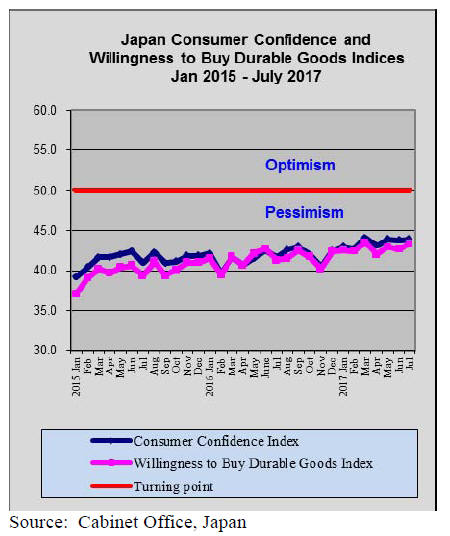
Dollar weakens in face of weaker than expected
inflation ¨C yen strengthens
The yen gained strength over the past two weeks driven by
the weaker U.S Dollar. Analysts suggest this is because
economic reports from the US highlight that inflation in
the US is not matching the Federal Reserve¡¯s targets.
The yen is hovering at the 110 to the dollar level. Despite
the uncertainty over the ability of the US administration to
advance its policies the US economy is described as
inflation free and healthy.
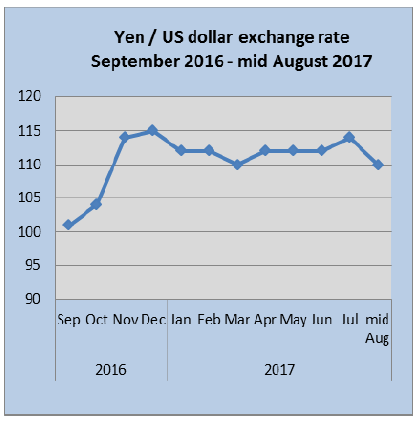
Investment in homes for rent continues ¨C Bank of
Japan issues advisory to regional banks
Data from Japan¡¯s Ministry of Land, Infrastructure,
Transport and Tourism shows that June housing starts rose
sharply (+11%) from a month earlier. However, year on
year starts are up just under 2%.
With the latest rise annualised housing starts would come
in at 1.003 million. The forecast level for 2017 was
987,000. House builders report a recover in the number of
orders received after two months of declines.
Much of the recent growth in housing starts has been
driven by construction of homes and apartments financed
by individuals building on their own land as a tax-saving
measure. Builders are seizing on this opportunity to secure
orders and the domestic banks are actively promoting low
interest loans for buildings to boost their loan portfolios.
However, as the number of available homes rises landlords
are finding it increasingly difficult to attract tenants and
rents are falling. This problem is worst for those who have
been encouraged to build condominiums in areas,
especially rural areas, where there are few job
opportunities and communications are poor.
According to a statement from the Bank of Japan,
outstanding loans provided by banks continue to rise
(currently at an 8 year high) ¡°supported by rises in the
amount of loans provided to real estate [businesses] such
as those for apartments.¡±
The BOJ has strongly recommended that regional banks
must be cautious in extending loans for building for rent
without first checking average rental fees and occupancy
rates in the surrounding area.
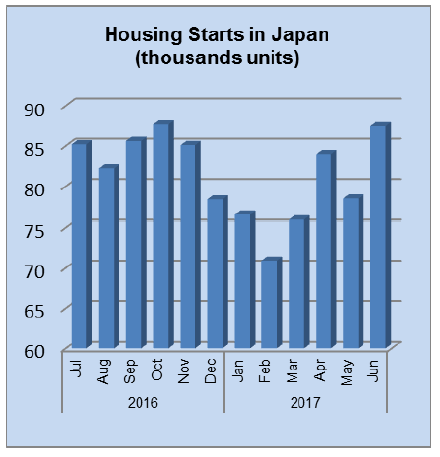
Import round up
Doors
Japan¡¯s imports of wooden doors (HS 441820) in the first
half of 2017 fell 12% compared to the first half of 2016.
Year on year June imports dropped 9% and there was a
slight decline in June 2017 imports compared to levels in
May.
The three main suppliers in June were China (54%), the
Philippines (20%) and Indonesia (12.5%). These three
have consistently topped the league of suppliers for the
past 12 months. It is not yet clear if the volatility in
wooden doors imports observed in the early part of this
year has ended.

Windows
Japan¡¯s imports of wooden windows (HS 441810) in the
first half of 2017 fell 9% compared to the first half of
2016.
In May this year there was a turn-around in the value of
wooden window imports when there was a 20% surge in
the value of imports. This upward trend continued into
June with a further 5% increase. However, year on year
there has been virtually no expansion of wooden window
imports into Japan.
The main suppliers of wooden windows to Japan in June
this year were China (30%), the philippines (28%) and the
USA (25%).
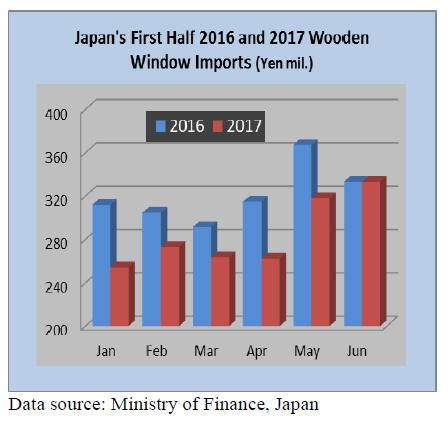
Assembled flooring
The volatility in imports of assembled wooden flooring
(HS441871-79) observed in the year to-date continues.
After dropping in May imports in June were up almost
30%. Year on year flooring imports have increased 46%.
The growth in Japan¡¯s wooden flooring imports in the first
half of 2017 compared to the same period in 2016 were up
22%. Most of the flooring imports are of HS 441875
(around 60%) with China being the main supplier
followed by Indonesia. HS441879 shippers to Japan in the
first half were mainly Indonesia, China and Thailand.
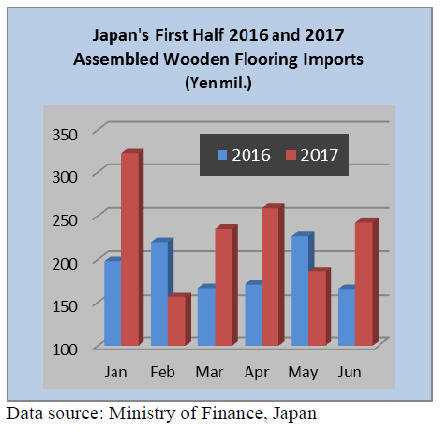
Plywood
In the first half of 2017 Japan¡¯s imports of plywood
(HS441210-39) were 8% above the level in the first half of
2016. Despite the overall rise June imports were
disappointing, falling almost 19% compared to levels
recorded for May. Year on year June imports of plywood
were down 11%.
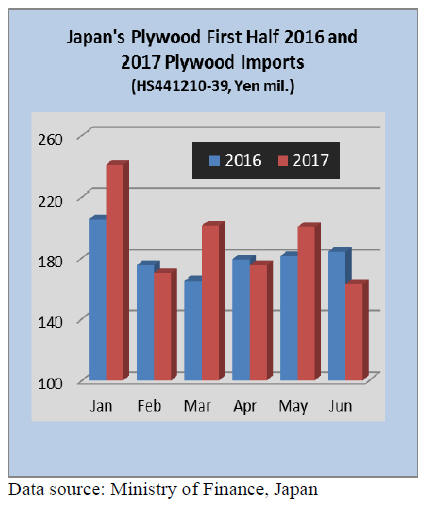
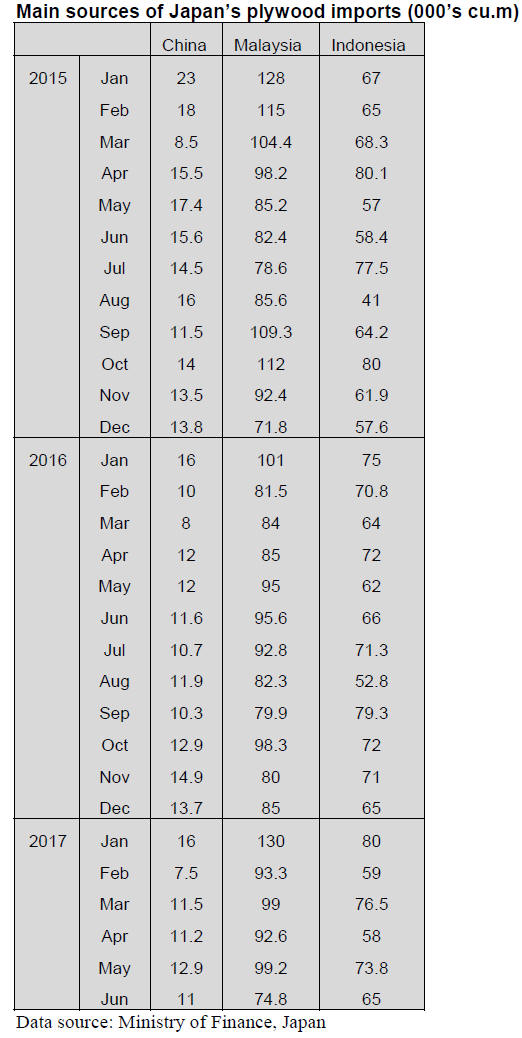
Trade news from the Japan Lumber Reports (JLR)
For the JLR report please see:
http://www.nmokuzai.
com/modules/general/index.php?id=7
EPA negotiations with EU concluded
EPA (Economic Partnership Agreement) negotiations with
EU (European Union) concluded on July 6.
In wood products export from EU to Japan, it is agreed
that the duty will be phased out in seven years after the
EPA goes into effect on ten items of softwood lumber like
lamina and stud, structural laminated lumber, OSB and
particleboard, processed wood like solid wood flooring,
piling and beam, other wood products including CLT, keg
and barrel, decorative laminated lumber, softwood
plywood and hardwood plywood.
At the negotiations, EU insisted immediate removal of the
duty on structural laminated lumber, which was agreed on
immediate abolishment at TTP (Trans Pacific Trade
Partnership) but Japan refused since it will give serious
impact to the domestic industry. After hard negotiations,
phasing out is the final settlement.
On the ten items, the duty is reduced by 0.3-0.8% in every
year and will be zero in eighth year. Assuming it becomes
effective in 2020, it will be zero in 2027.
In TPP, there is safeguard to impose duty if import
volume reaches a certain level but in the agreement with
EU, there is no safeguard.
Wood demand projection for 2017
The Forestry Agency held the first wood demand
projection meeting. New housing starts forecast by eleven
private think tanks based on GDP for the first quarter is
940,000 units, 3.5% less than 2016¡¯s 974,000 units.
Meantime, in wood supply projection, structural laminated
lumber is up by 5.2% and plywood is up by 3.2%. Increase
of domestic manufacturing on both items by newly build
manufacturing facilities. Since there is a gap between
declining housing starts and increasing supply of building
materials, over-supply may become problem.
Supply projection of structural laminated lumber for 2017
is 7.4% up of domestic products and 1.0% up of the
imports. Domestic production will increase significantly
by starts-up of new manufacturing facilities. Actually, the
first quarter production was 15.3% more than the same
period of last year and the second quarter supply
projection is 10.0% more then the third quarter would be
flat and the fourth quarter may drop down some due to
uncertain demand.
The imports of laminated lumber for the first quarter were
25.9% more but the second quarter would be down by
12.2% by supply skip for March and April by major
supplier in Rumania and delayed shipments by other
suppliers. Third quarter supply would be down by 13% as
Rumanian supply would be down by 50%.Therefore, total
year supply would be the same as last year.
The demand for the third quarter is the same as last year
on redwood laminated beam but that of laminated post
would be down.
Plywood supply projection is domestic would be up by
3.6% and the imports would be up by 2.7%.
Domestic production for the first quarter was 0.7% more
than the first quarter 2016. The supply for the second and
third quarter would be flat or larger so the supply of
domestic logs for plywood mills will be more than last
year.
The demand for plywood would be slightly up for the third
quarter then be down in the fourth quarter.
Imported plywood will have continuous demand for floor
base then in the fourth quarter, demand increase for
concrete forming panels is expected with increasing starts
of condominiums.
Supply of domestic logs for 2017 is down by 2.5% for
lumber while up by 0.4% for plywood so overall supply
would be down by 1.9%.
On imported logs and lumber, decrease is forecasted for
all the sources from North America, Russia, South Sea,
New Zealand and Chile.
Growing log export
According to the statistics the Ministry of Finance makes
up, cedar log export for the first five months of this year is
57.9% more than the same period of last year with the
volume of 294,616 cbms. Cypress log export was 61,014
cbms, 43.0% more than last year.
Yen¡¯s exchange rate has been weak to the dollar, which
helps increase log export and Chinese economy is stable.
Dominant shipping region is Kyushu. Hokkaido, Akita and
Aomori have new exporting ports. Supply side reason to
stimulate log export is excessive supply of logs for
biomass power generation plants. All the biomass power
generation plants improves efficiency of use of local logs
together with use of other materials like PKS.
There is no new plan of large biomass power plant except
for ones to use imported fuel like PKS and wood pellet so
future plants are small in size of less than 2,000 kw.
Therefore, demand for logs for biomass power plants will
not increase much any longer so unless log suppliers
reduce log supply, there will be structural over supply.
Log export market is replacing market of surplus logs
produced for biomass power plants.
Including hardwood logs, total log export for the first five
months are 375,104 cbms, 49.2% more than 2016. Total
log export volume in 2016 was 650,414 cbms.
Assuming this year¡¯s log export would continue 50% more
pace, 2017 total would be nearly 1,000 M cbms. At the
same time, lumber export for the same period of time was
50,319 cbms, 57.9% more so total year would be 100 M
cbms.
South Sea (tropical) logs
Prolonged rainy season in Sarawak, Malaysia is finally
over but log production continues to be tight and port log
inventories are very limited. One of major reasons of tight
production is newly imposed regulation, which bans
harvest of any timber with 50 centimeter at breast high.
This was 35 centimeter before.
Harvest quota for 2017 has been notified to log harvesters
and volume of new quota is 20-30% less than 2016.
Also allocation percentage for local consumption and
export is changed from 70% domestic to 80% and export
is down to 20% from 30%.
India, the main log buyer in Sarawak, continues aggressive
purchase. India introduced new GST (sales tax) since July
and rush-in import occurred before this tax is imposed.
India is proposing US$40-50 per cbm FOB on meranti
regular so FOB prices for Japan are pushed up by US$20-
30 high, getting close to US$300.
India is also purchasing logs in PNG and Solomon Islands
so the log prices in these areas are going up also.
In Sarawak, new timber premium is introduced, which is
another factor of higher log cost so log availability
continues tight.
Indonesian laminated free board manufacturing plants are
down by Islamic Ramadan. Japan market is not active so
the supply and demand is balanced but export prices are
firming at more than US$900 per cbm C&F.
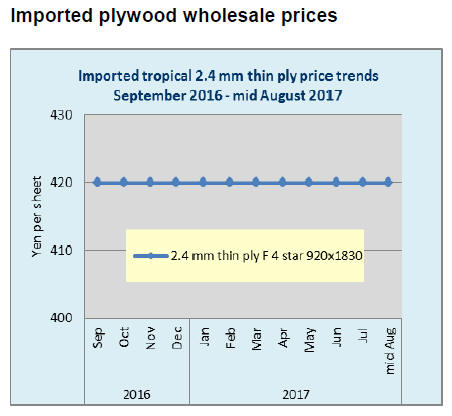
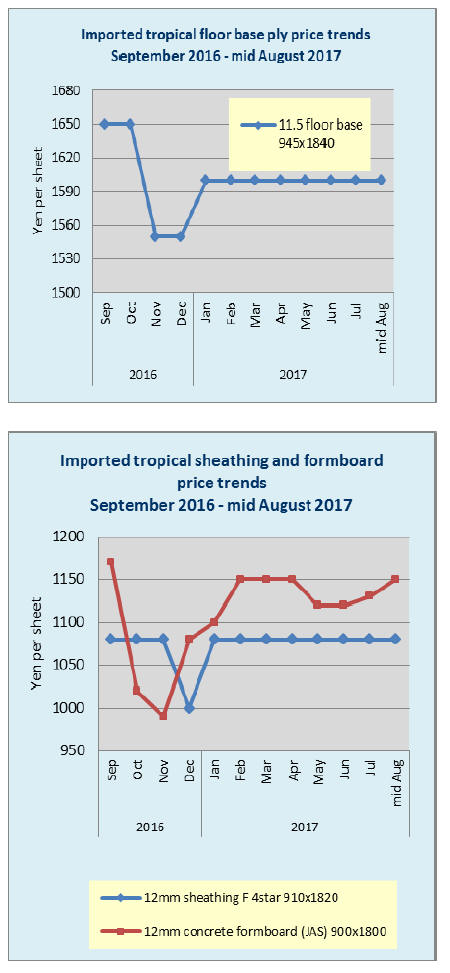
|